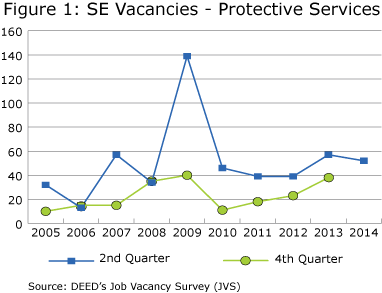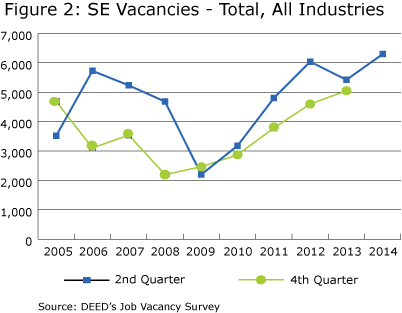by Mark Schultz
February 2015
About 3,650 people are employed in protective services occupations in Southeast Minnesota, accounting for about 1.5 percent of total regional employment. While many consider police officers as the main occupation in protective services, this is not the case in Southeast Minnesota. Correctional officers and jailers make up the highest proportion, representing 20.6 percent of those employed in protective services. Police and sheriff's patrol officers represent 19.2 percent of the total number of protective service employees in the region. Coming in third are security guards who make up 17.3 percent. These three occupations comprise 57.1 percent of all jobs in protective services, according to DEED's Occupational Employment Statistics (Table 1).
| Employment and Wages for Protective Service Occupations | ||||||
|---|---|---|---|---|---|---|
| Occupation Title | Median Hourly Wage | Estimated Employment | ||||
| Southeast | Minnesota | United States | Southeast | Minnesota | United States | |
| Protective Services, All | $19.43 | $18.88 | $17.82 | $3,650 | 44,020 | 3,257,690 |
| First-Line Supervisors of Correctional Officers* | $31.09 | $32.34 | $27.95 | 90 | 570 | 44,980 |
| First-Line Supervisors of Police and Detectives | $35.30 | $39.87 | $38.36 | 190 | 2,280 | 101,320 |
| First-Line Supervisors of Fire Fighting and Prevention Workers* | $35.64 | $35.20 | $33.94 | 60 | 730 | 59,700 |
| First-Line Supervisors of Protective Service Workers* | $22.40 | $22.63 | $22.21 | 90 | 1,080 | 64,510 |
| Fire Fighters* | $15.81 | $13.62 | $22.09 | 320 | 5,700 | 302,670 |
| Bailiffs* | $23.71 | $20.10 | $17.97 | 80 | 170 | 16,360 |
| Correctional Officers and Jailers* | $21.03 | $21.80 | $19.17 | 740 | 4,480 | 432,680 |
| Detectives and Criminal Investigators | $27.59 | $33.23 | $37.17 | 90 | 1,090 | 109,960 |
| Police and Sheriff's Patrol Officers | $24.96 | $29.43 | $27.20 | 690 | 8,840 | 635,380 |
| Security Guards | $11.50 | $13.19 | $11.66 | 620 | 11,600 | 1,066,730 |
| Lifeguards, Ski, and Other Recreational Protective Workers | $8.92 | $9.26 | $9.23 | 270 | 2,400 | 130,700 |
| Transportation Security Screeners | $16.74 | $18.04 | $17.97 | 20 | 750 | 45,790 |
| Protective Service Worker, All Other* | $15.29 | $16.84 | $14.54 | 330 | 2,810 | 96,260 |
| * Occupation pays higher in the Southeast region than in the state, country, or both.
Source: DEED's Occupational Employment Statistics |
||||||
This trend is not the same throughout the state. Police and sheriff's patrol officers and security guards still remain in the top three as far as employment is concerned, but the rankings are reversed as security guards are the largest protective services occupation in the state at 27.0 percent, and police and sheriff's patrol officers remain second with 20.6 percent. Statewide, firefighters replace correctional officers and jailers in third place, 13.1 percent of the employees in this occupational group, while correctional officers still represent a rather significant proportion of protective services employees at 10.4 percent. These four occupations make up two-thirds or 66 percent of the employees in this field in the Southeast region, less than the 72.0 percent these top occupations represent in the total state.
As Table 1 shows, median wages for protective services as an occupational group are relatively high at $19.43 per hour, and many jobs in this field pay even higher wages. Not surprisingly, the highest wages are reported in supervisory positions for firefighting and prevention workers ($35.64), police and detectives ($35.30), and correctional officers ($31.09). Many times these supervisory positions can be obtained with experience over time, not necessarily by obtaining additional degrees, certificates, or licenses.
For example, in the Minnesota Department of Corrections most Lieutenants and Captains have worked their way up from a Correctional Officer Trainee, through the ranks of Correctional Officer I, Correctional Officer II, and Sargent to reach higher levels. Many other jobs requiring more experience or education within the protective services industry also pay higher wages, including detectives and criminal investigators ($27.59), police and sheriff's patrol officers ($24.96), bailiffs ($23.71), correctional officers ($21.03), and transportation security screeners ($16.74). Although many occupations earn less in the Southeast region than in the state or country, most protective services occupations earn more.
The number of protective services job vacancies has shown a relatively steady increase over time, even jumping to its highest number ever in the second quarter of 2009 during the recession. Vacancies have been fairly consistent within protective services except for 2009, whereas there is more variation from year to year in vacancies across all industries (Figures 1 and 2). As Figure 1 shows, the number of job vacancies in protective services is typically higher in the second quarter than the fourth quarter.


Of the protective services vacancies in Southeast Minnesota, 80 percent are part-time compared to 66 percent statewide, and 35 percent are temporary or seasonal, compared to 25 percent in Minnesota. While this may seem discouraging, especially to those who want to start a career in this field, these part-time and temporary/seasonal jobs offer opportunities to gain valuable experience. In addition, those who are attending post-secondary school in a criminal justice program can work part-time or at a temporary/seasonal job in protective services. According to DEED's Job Vacancy Survey, 24 percent of the vacancies in protective services require one or more years of experience.
Strangely, just 7 percent of protective services job vacancies in the region require post-secondary education, while statewide 30 percent require this level of educational attainment. This is excellent news for job seekers who choose not to get an education past high school. For example, correctional officers with the Minnesota Department of Corrections do not need to have more than a high school education, and a career as an officer offers good wages and job security, as there will always be a need for officers in the state's prisons and jails.
Sixty percent of the vacancies in the Southeast region require at least a certificate or license. There are many options - including associate and bachelor's degrees in criminal justice - for those who choose to further their education past high school. Experience in the field can also make candidates better qualified for graduate programs in criminal justice. Experience allows individuals to start in more advanced protective service occupations, such as investigators and detectives.
Regional projections for the next decade show that all of the occupations in the protective services industry will have openings, although some will need very few new workers. In sum, protective services occupations will need about 1,500 new workers in Southeast Minnesota from 2012 to 2022, but nearly 1,300 of those are replacement openings, which are from retirements or career changes rather than new job growth. The only occupation seeing a notable increase in new jobs is security guards.
As such, the largest number of openings overall is projected for security guards, followed closely by police and sheriff's patrol officers and other protective service workers, which would include jobs in retail loss prevention, community service officers, probation agents, polygraph examiners, surveillance system monitors, and any other job not listed separately in Table 2. Correctional offices and jailers are also expected to have a large number of openings, despite seeing a decline in the number of jobs.
| Employment Projections in Protective Services, Southeast Minnesota | ||||||
|---|---|---|---|---|---|---|
| SOC Occupational Title | Estimated Employment 2012 | Projected Employment 2022 | Numeric Change 2012-2022 | Percent Change 2012-2022 | Replacement Openings, 2012-2022 | Total Openings, 2012-2022 |
| Total, All Occupations | 262,725 | 279,634 | 16,909 | 6.4% | 60,748 | 80,879 |
| Protective Service Occupations | 4,063 | 4,142 | 79 | 1.9% | 1,295 | 1,481 |
| First-Line Supervisors of Correctional Officers | 86 | 83 | -3 | -3.5% | 30 | 30 |
| First-Line Supervisors of Police and Detectives | 204 | 194 | -10 | -4.9% | 60 | 60 |
| First-Line Supervisors of Fire Fighting and Prevention Workers | 67 | 64 | -3 | -4.5% | 29 | 29 |
| First-Line Supervisors of Protective Service Workers, All Other | 91 | 98 | 7 | 7.7% | 21 | 28 |
| Firefighters | 440 | 421 | -19 | -4.3% | 120 | 120 |
| Fire Inspectors and Investigators | 14 | 13 | -1 | -7.1% | 4 | |
| Bailiffs | 13 | 13 | 0 | 0.0% | 3 | 3 |
| Correctional Officers and Jailers | 742 | 710 | -32 | -4.3% | 197 | 197 |
| Detectives and Criminal Investigators | 76 | 73 | -3 | -4.0% | 17 | 17 |
| Police and Sheriff's Patrol Officers | 784 | 752 | -32 | -4.1% | 246 | 246 |
| Animal Control Workers | 10 | 10 | 0 | 0.0% | 2 | 2 |
| Private Detectives and Investigators | 16 | 21 | 5 | 31.3% | 4 | 9 |
| Gaming Surveillance Officers and Gaming Investigators | 30 | 31 | 1 | 3.3% | 5 | 6 |
| Security Guards | 821 | 980 | 159 | 19.4% | 126 | 285 |
| Crossing Guards | 21 | 20 | -1 | -4.8% | 3 | 3 |
| Lifeguards, Ski, and Other Recreational Protective Service Workers | 279 | 281 | 2 | 0.7% | 191 | 193 |
| Transportation Security Screeners | 22 | 21 | -1 | -4.6% | 5 | 5 |
| Protective Service Workers, All Other | 336 | 348 | 12 | 3.6% | 230 | 242 |
| Source: DEED's Employment Outlook Tool | ||||||
Although protective services will likely always require people, technology is having a great impact on the field. Not only has crime become more technologically advanced, crime fighting methods have also evolved. Almost every crime includes some element of technology, with cell phones at the forefront of this trend, according to Marshall Ogren, a detective specializing in digital forensics.
Nearly everyone now carries cell phones equipped with cameras, which can be used by witnesses to photograph or record crimes as they happen. In the same way, investigators can use the perpetrators' cell phones or computer history to look at texts or other messages for clues about the crimes committed. Ogren uses smartphones and a specialized forensics computer and software programs to investigate crimes.
To be competitive in this field, applicants have to be proficient with technology. In addition, Ogren said that agencies will want to recruit and hire new people with specialized training in technology such as personnel to investigate cyber security crimes or trainers to increase the skills of existing employees. While there are already some protective services jobs that require the use of cutting-edge crime fighting technology, few people work in them according to Ogren. But he believes there will be many new jobs requiring technology skills in the future.
It's safe to say that the protective services industry will continue to see growth and openings in the future. With many jobs in this industry paying well and willing individuals who want to be part of protecting Southeast Minnesota, whether it be on the streets, in a prison or jail, or fighting blazes, Minnesotans can feel safe in their neighborhoods, cities, and counties in the Southeast region.